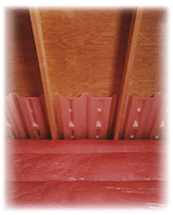Radiant barriers (foil, mylar, etc) are only minimally effective in a cold climate--generally they are not worth the trouble. It also needs to be open (not in contact with anything) on at least one side (if the foil is just sandwhiched inside other materials you don't have a radiant barrier). Lots of gimmicky radiant barrier snake oil out there, but for a home in the midwest I think you'd be wasting your time. The Dept of Energy web sites can tell you al you need to know.
Fiberglass (either in batts or loose-fill blow-in stuff) has a couple of problems. It really only maintains its stated R-value at very low differences in temperature (e.g. warm side at 70 deg, cool attic at 60 deg). Because air can move through it relatively freely (it's the same stuff cheap furnace filters are made of), convection currents start working at drawing heat out of it when the tep differences get big. When temps really dip down (0 deg), fiberglass insulaton can have as little as 50% of it's rated capacity for this reason. Also, fiberglass fibers do cause lung disease, so if you are working around the stuff, wear a good mask/respirator.
Cellulose blow in insulation has many advantages. It costs about 50% of what fiberglass costs, and the fibers are not hazardous. Because it is dense, it forms a barrier to air movement and convection--it keeps it's rated R-value regardless of temp difference. All the cellulose you can buy today is treated to inhibt mold growth and fire (the fire tests results are very impressive--boric acid is amazing stuff). It's also very environmentally friendly (made of ground up newspaper) and has much less embodied energy than fiberglass. It CAN hold a lot of water, which is a downside if you have a roof leak. If you've alrfeady got fiberglass batts or loose fill, adding just a few inches of celllose can make it much more efffective on cold days by cutting off the convection problem.
DW and I installed 15" of cellulose in our attic before last winter, it was a really good project. She was outside dumping the bales into the machine, I was upstairs in the attic blowing the insulation. Don't forget to add troughs for the soffit venting before you add the insulation (whichever type you add).
Good luck!


